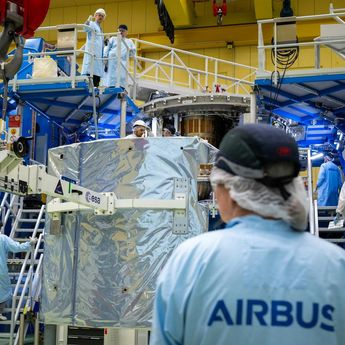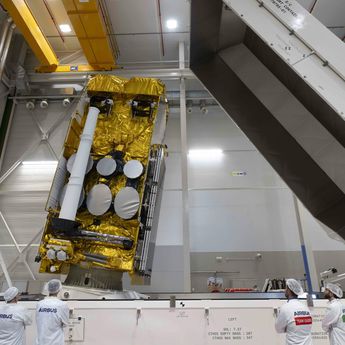Following humankind’s successful first steps back toward the Moon with last year’s Artemis mission – powered by the Airbus-built European Service Module – the company is now ready for a key role in another important new space venture: a flight to Jupiter that is set to start this spring.
What is JUICE and what is its mission?
JUICE (JUpiter ICy moons Explorer) is the first European spacecraft to go to Jupiter. Its primary goal is to understand whether the oceans of these icy Jovian moons could sustain life.
JUICE will spend over eight years travelling the 600 million kilometres to reach our solar system’s largest planet, where its instruments will focus on three of Jupiter’s biggest moons: Ganymede, Europa and Callisto.
To reveal more about this fascinating planet and its natural satellites, JUICE’s “eyes” and “ears” are composed of 10 state-of-the-art scientific instruments, including cameras, spectrometers, an ice-penetrating radar, a radio-science experiment and sensors.

Once in the vicinity of Jupiter, JUICE will spend four years gathering data – including nine months orbiting Ganymede, which will mark the first time a spacecraft orbits a moon other than our own. JUICE will analyse this icy Jovian moon’s nature and evolution, characterising its subsurface ocean, and investigating potential habitability.
JUICE will also focus on Jupiter itself, gathering data on the gas giant planet’s atmosphere, from its cloudy layers to the ionosphere and auroras. The spacecraft’s instruments will look at different wavelengths of light to provide new insights into how temperatures, wind patterns and chemistry are changing in this never-before-seen part of Jupiter’s atmosphere.

A European team for JUICE
Bringing together 80 partners across 23 countries and harnessing the brainpower of 2,000+ people, Airbus has designed and built JUICE under contract to the European Space Agency (ESA).
“It’s been a long Earthly journey through various sites towards final integration and flight readiness”, says Cyril Cavel, JUICE project manager. “It is truly an international accomplishment, involving more than 80 companies across Europe and close to 500 team members in Airbus alone."
One of the key spacecraft features is its solar arrays, made by Airbus’ site in Leiden, the Netherlands. Covering a total surface area of 85 square metres, these are one of the largest solar arrays of its type ever built. This phenomenal size - a bit larger than a badminton court - is essential because Jupiter is so far from the sun that large arrays are needed to deliver the power necessary for the spacecraft and its instruments.
What has to happen before launch?
We are truly on the home straight now: JUICE was shipped from the Airbus production site in Toulouse, France to South America, where it is now undergoing final preparations by our engineers before launch on 13 April by an Ariane 5 rocket from French Guiana.
By going even deeper into space with JUICE, Airbus will contribute to the further understanding of our solar system, with this spacecraft’s data potentially answering questions on how planets are formed and where life may have emerged - stay tuned to follow this exciting journey!
- More information on JUICE here
- For additional Airbus Space Exploration missions visit our dedicated Exploration section
Discover more Space news
Continue Reading

Airbus ships fourth European Service Module for Artemis IV
Press Release
Space
Fourth European Service Module (ESM-4) is ready to leave Airbus’ facilities in Bremen, Germany, and be shipped to NASA’s Kennedy Space Center, Florida, USA
Sentinel-1D: the radar that never sleeps
Web Story
Space

Airbus-built SpainSat NG-II secure communications satellite successfully launched
Press Release
Space

Airbus, Leonardo and Thales sign Memorandum of Understanding to create a leading…
Press Release
Company

Tracking air pollution from space
Web Story
Space
